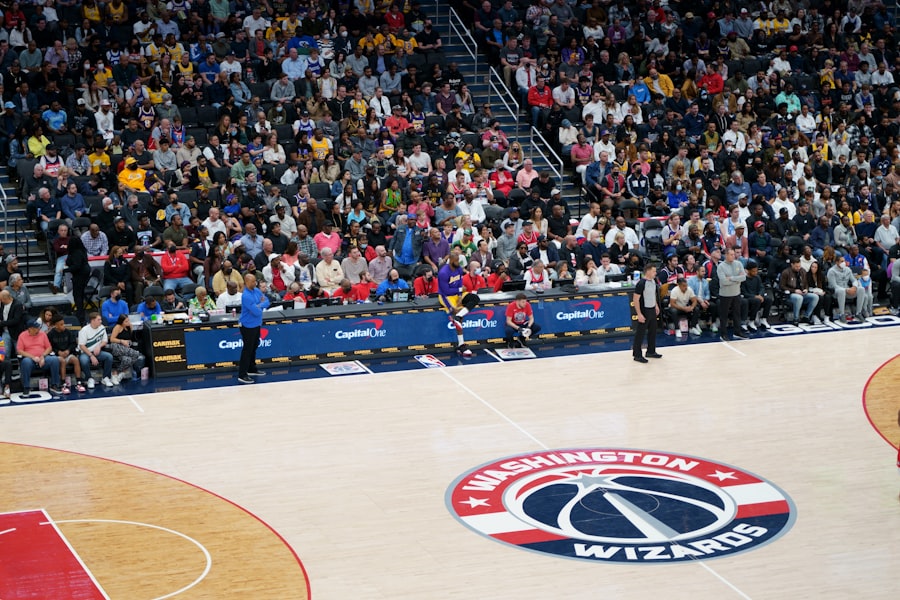The evolution of NBA uniforms is a fascinating journey that reflects not only the changing aesthetics of basketball but also the broader cultural shifts within society. When the league was founded in 1946, uniforms were relatively simple, often consisting of basic designs with minimal embellishments. Teams typically wore solid colors with their names emblazoned across the chest, and the players’ numbers were often the only distinguishing feature.
For instance, the Boston Celtics’ iconic green and white uniform has remained largely unchanged since its inception, symbolizing tradition and continuity in a league that has undergone significant transformation. As the decades progressed, so too did the design and functionality of NBA uniforms. The 1970s marked a turning point, as teams began to experiment with more vibrant colors and unique designs.
The introduction of synthetic fabrics allowed for greater flexibility and comfort, enabling players to perform at their best. The Los Angeles Lakers, for example, embraced a bold purple and gold color scheme that became synonymous with their identity. By the 1990s, the NBA saw an explosion of creativity in uniform design, influenced by hip-hop culture and street fashion.
Teams like the Toronto Raptors and the Miami Heat introduced bold graphics and unconventional color palettes, reflecting a new era of self-expression within the sport.
Key Takeaways
- NBA uniforms have evolved significantly in design and functionality over time.
- Advertising partnerships have introduced new branding opportunities on NBA uniforms.
- Technological advancements have enhanced the materials and customization of uniforms.
- Advertising deals provide substantial financial benefits to NBA teams.
- The integration of ads on uniforms affects fan experience and raises some controversies.
The Impact of Advertising Partnerships on NBA Uniforms
In recent years, advertising partnerships have significantly altered the landscape of NBA uniforms. The introduction of jersey sponsorships in 2017 marked a pivotal moment in the league’s history, allowing teams to display corporate logos on their uniforms for the first time. This shift not only provided teams with a new revenue stream but also transformed the visual identity of the uniforms themselves.
For example, the Philadelphia 76ers partnered with StubHub, featuring their logo prominently on their jerseys, which not only enhanced brand visibility but also created a new narrative around team identity. The impact of these advertising partnerships extends beyond mere aesthetics; they have also influenced fan engagement and loyalty. Teams are now able to forge deeper connections with their sponsors, creating promotional events and campaigns that resonate with fans.
The Golden State Warriors’ partnership with Rakuten exemplifies this trend, as they have integrated the brand into various fan experiences, from exclusive merchandise to digital content. This symbiotic relationship between teams and sponsors has redefined how fans interact with both the sport and its commercial aspects.
The Role of Technology in Revolutionizing NBA Uniforms

Technology has played a crucial role in revolutionizing NBA uniforms, enhancing both performance and fan engagement. Advances in fabric technology have led to the development of moisture-wicking materials that keep players dry and comfortable during intense games. Nike’s Dri-FIT technology, for instance, has become a staple in modern NBA uniforms, allowing for improved breathability and flexibility.
This innovation not only benefits players on the court but also enhances the overall aesthetic appeal of the uniforms, as they maintain their shape and color even after rigorous use. Moreover, technology has enabled teams to incorporate smart features into their uniforms. The integration of RFID chips allows for real-time tracking of player performance metrics during games, providing coaches with valuable insights into player health and efficiency.
This data-driven approach is transforming how teams strategize and prepare for games, ultimately impacting the outcome on the court. Additionally, augmented reality (AR) experiences are becoming more prevalent in fan interactions with uniforms. For example, fans can use AR apps to see player stats or historical highlights by scanning specific elements of a jersey, creating an immersive experience that bridges the gap between traditional sports viewing and modern technology.
The Financial Benefits of Advertising Partnerships for NBA Teams
| Metric | Description | Example Value | Impact on NBA Teams |
|---|---|---|---|
| Revenue from Sponsorship Deals | Income generated from advertising partnerships and sponsorship agreements | 50 million | Provides a significant portion of team operating budgets |
| Increase in Merchandise Sales | Boost in sales due to co-branded advertising campaigns | 15% growth | Enhances overall team revenue streams |
| Ticket Sales Growth | Increase in game attendance driven by promotional advertising | 10% increase | Improves game-day revenue and fan engagement |
| Brand Exposure Value | Estimated value of media exposure from advertising partnerships | 75 million | Raises team profile and attracts further sponsorships |
| Digital Advertising Revenue | Income from online ads and social media partnerships | 20 million | Expands revenue through digital platforms |
| Cost Savings on Marketing | Reduction in marketing expenses due to partner collaborations | 5 million | Improves profitability by lowering operational costs |
The financial benefits of advertising partnerships for NBA teams are substantial and multifaceted. With the introduction of jersey sponsorships, teams have unlocked a lucrative revenue stream that was previously untapped. According to estimates from industry analysts, NBA teams can earn anywhere from $5 million to $20 million annually from jersey sponsorships alone, depending on market size and team popularity.
This influx of revenue allows teams to invest in player development, facilities, and community outreach programs, ultimately enhancing their competitiveness both on and off the court. Furthermore, these partnerships often extend beyond just jersey logos; they can encompass a wide range of marketing initiatives that generate additional income. For instance, teams may collaborate with sponsors on promotional nights or special events that draw fans to games while simultaneously boosting brand visibility for sponsors.
The Boston Celtics’ partnership with General Electric illustrates this point well; through joint marketing campaigns and community initiatives, both entities benefit from increased exposure and engagement. As teams continue to explore innovative advertising strategies, the financial landscape of the NBA is likely to evolve further, creating new opportunities for growth.
The Fan Experience and Advertising on NBA Uniforms
The integration of advertising on NBA uniforms has transformed the fan experience in various ways. While some purists may lament the commercialization of sports, many fans appreciate the added dimension that these partnerships bring to their engagement with teams. For instance, jersey sponsorships often come with exclusive promotions or discounts for fans who purchase merchandise featuring sponsor logos.
This creates a sense of connection between fans and brands while also enhancing their loyalty to their favorite teams. Moreover, advertising partnerships can lead to unique fan experiences that go beyond traditional game-day activities. Teams are increasingly leveraging their sponsors to create interactive events that engage fans in new ways.
The Miami Heat’s collaboration with local businesses has resulted in themed game nights where fans can enjoy special promotions tied to sponsor brands. These initiatives not only enhance the overall atmosphere at games but also foster a sense of community among fans who share similar interests in both basketball and local businesses.
The Future of NBA Uniforms and Advertising Partnerships

Looking ahead, the future of NBA uniforms and advertising partnerships appears poised for further evolution as technology continues to advance and consumer preferences shift. One potential direction is the increased use of digital advertising on uniforms, allowing for dynamic content that can change based on various factors such as game location or opponent. This could create a more personalized experience for fans while providing sponsors with greater flexibility in their marketing strategies.
Additionally, as sustainability becomes an increasingly pressing concern across industries, NBA teams may explore eco-friendly materials for their uniforms that align with corporate social responsibility goals. Brands that prioritize sustainability could find themselves at an advantage when partnering with teams that share similar values. This alignment could lead to innovative designs that not only look good but also contribute positively to environmental efforts.
The Challenges and Controversies of Advertising on NBA Uniforms
Despite the financial benefits associated with advertising partnerships on NBA uniforms, there are challenges and controversies that arise from this trend. One significant concern is the potential dilution of team identity as corporate logos become more prominent on jerseys. Fans may feel that their beloved teams are becoming mere vehicles for corporate branding rather than representing their community or heritage.
This sentiment can lead to backlash from loyal supporters who value tradition over commercialization. Moreover, there are ethical considerations surrounding which brands are allowed to partner with teams. For instance, if a team aligns itself with a controversial company or product—such as those related to gambling or alcohol—it could alienate certain segments of its fan base.
Striking a balance between financial gain and maintaining a positive image is crucial for teams navigating this complex landscape.
The Global Reach of NBA Uniform Advertising Partnerships
The global reach of NBA uniform advertising partnerships is another aspect that underscores the league’s influence beyond American borders. As basketball continues to grow in popularity worldwide, international markets present lucrative opportunities for both teams and sponsors alike. For example, Chinese companies have increasingly sought partnerships with NBA teams due to the sport’s immense following in China.
The partnership between the Houston Rockets and Chinese sportswear brand Li-Ning exemplifies this trend; it not only enhances brand visibility in Asia but also strengthens cultural ties between American basketball and Chinese consumers. Furthermore, as international games become more common—such as preseason matchups held in Europe or Asia—teams are likely to leverage these opportunities to showcase their sponsors on a global stage. This expansion into international markets allows brands to tap into diverse consumer bases while simultaneously elevating the profile of NBA teams abroad.
As globalization continues to shape sports marketing strategies, advertising partnerships on NBA uniforms will play an increasingly vital role in connecting brands with fans around the world.



